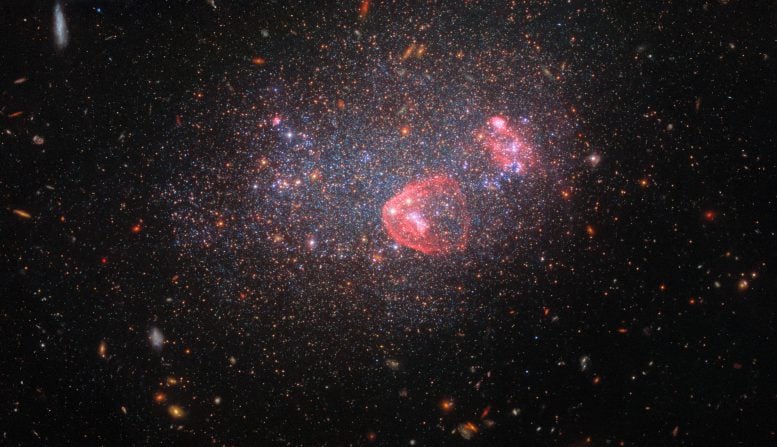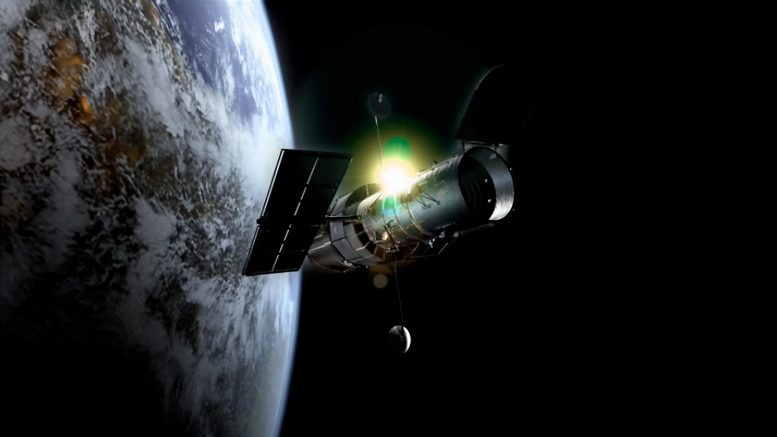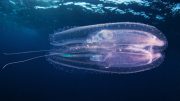
The billion stars in galaxy UGC 8091 resemble a sparkling snow globe in this festive Hubble Space Telescope image from NASA and ESA (European Space Agency). Credit: ESA/Hubble, NASA, ESA, Yumi Choi (NSF’s NOIRLab), Karoline Gilbert (STScI), Julianne Dalcanton (Center for Computational Astrophysics/Flatiron Inst., UWashington)
Dwarf Irregular Galaxy Springs to Life With Dazzling Newborn Stars
Hubble’s colorful snapshots show that the universe always looks like it’s in a holiday spirit. The dwarf irregular galaxy UGC 8091 is an opulent example. The dizzying interplay of matter and energy bubbles up to create dazzling blue, newborn stars that look like a festive string of lights. They are swaddled in glowing cocoons of hot, pink hydrogen gas. The galaxy is a collection of approximately 1 billion stars. That sounds like a lot, but it is 1/100th the stellar population inside our full-grown Milky Way galaxy.
This little galaxy came late to the party. The early universe was awash in dwarf galaxies that eventually merged to build up the majestic spiral galaxies around us today. Located 7 million light-years away, UGC 8091 more recently started showing off a glittering tapestry.

The Hubble Space Telescope is an iconic symbol of space exploration that launched into orbit in 1990. Hubble revolutionized astronomy by providing unprecedented clear and deep views of the universe, far beyond the distortion of Earth’s atmosphere. Credit: NASA
Hubble Space Telescope Presents a Holiday Globe of Stars
The billion stars in galaxy UGC 8091 resemble a sparkling snow globe in this festive Hubble Space Telescope image from NASA and ESA (European Space Agency).
The dwarf galaxy is approximately 7 million light-years from Earth in the constellation Virgo. It is considered an “irregular galaxy” because it does not have an orderly spiral or elliptical appearance. Instead, the stars that make up this celestial gathering look more like a brightly shining tangle of string lights than a galaxy.
Some irregular galaxies may have become tangled by tumultuous internal activity, while others have formed by interactions with neighboring galaxies. The result is a class of galaxies with a diverse array of sizes and shapes, including the diffuse scatter of stars that is this galaxy.
Twelve camera filters were combined to produce this image, with light from the mid-ultraviolet through to the red end of the visible spectrum. The red patches are likely interstellar hydrogen molecules that are glowing because they have been excited by the light from hot, energetic stars. The other sparkles on show in this image are a mix of older stars. An array of distant, diverse galaxies appear in the background, captured by Hubble’s sharp view.
The data used in this image were taken by Hubble’s Wide Field Camera 3 and the Advanced Camera for Surveys from 2006 to 2021.
Among other things, the observing programs involved in this image sought to investigate the role that dwarf galaxies many billions of years ago had in re-heating the hydrogen that had cooled as the universe expanded after the Big Bang.
Astronomers are also investigating the composition of dwarf galaxies and their stars to uncover the evolutionary links between these ancient galaxies and more modern galaxies like our own.
The Hubble Space Telescope is a project of international cooperation between NASA and ESA. NASA’s Goddard Space Flight Center in Greenbelt, Maryland, manages the telescope. The Space Telescope Science Institute (STScI) in Baltimore, Maryland, conducts Hubble and Webb science operations. STScI is operated for NASA by the Association of Universities for Research in Astronomy, in Washington, D.C.









Be the first to comment on "In a Universe of Wonders: NASA’s Hubble Presents a Holiday Globe of a Billion Stars"